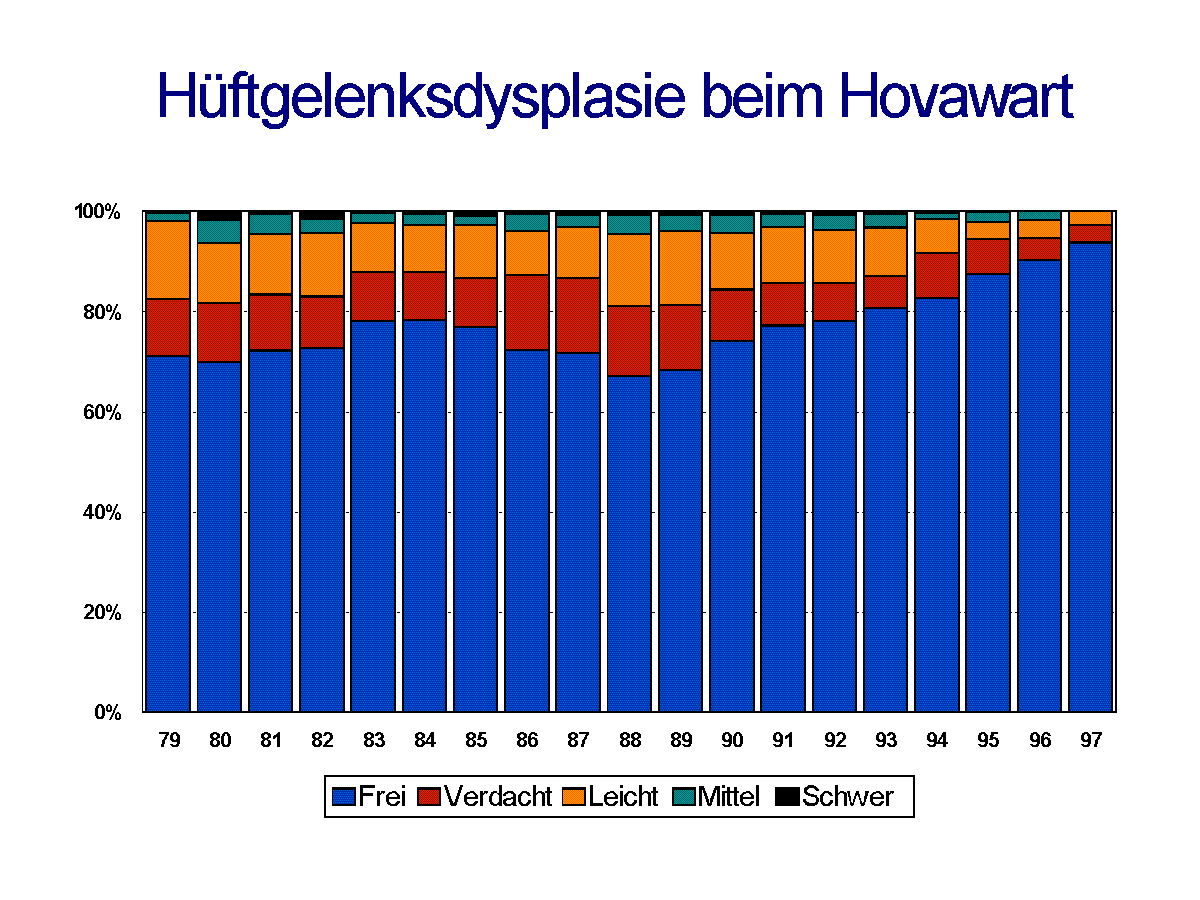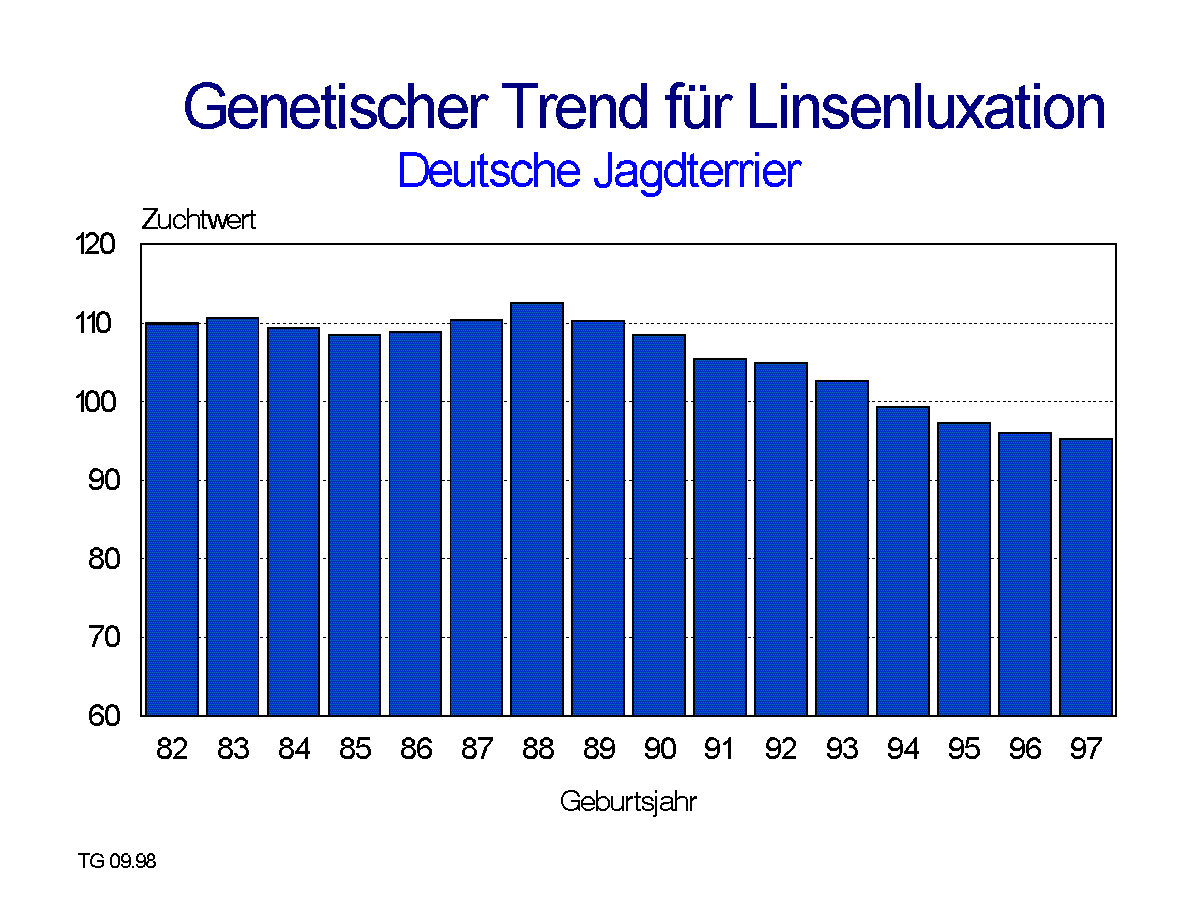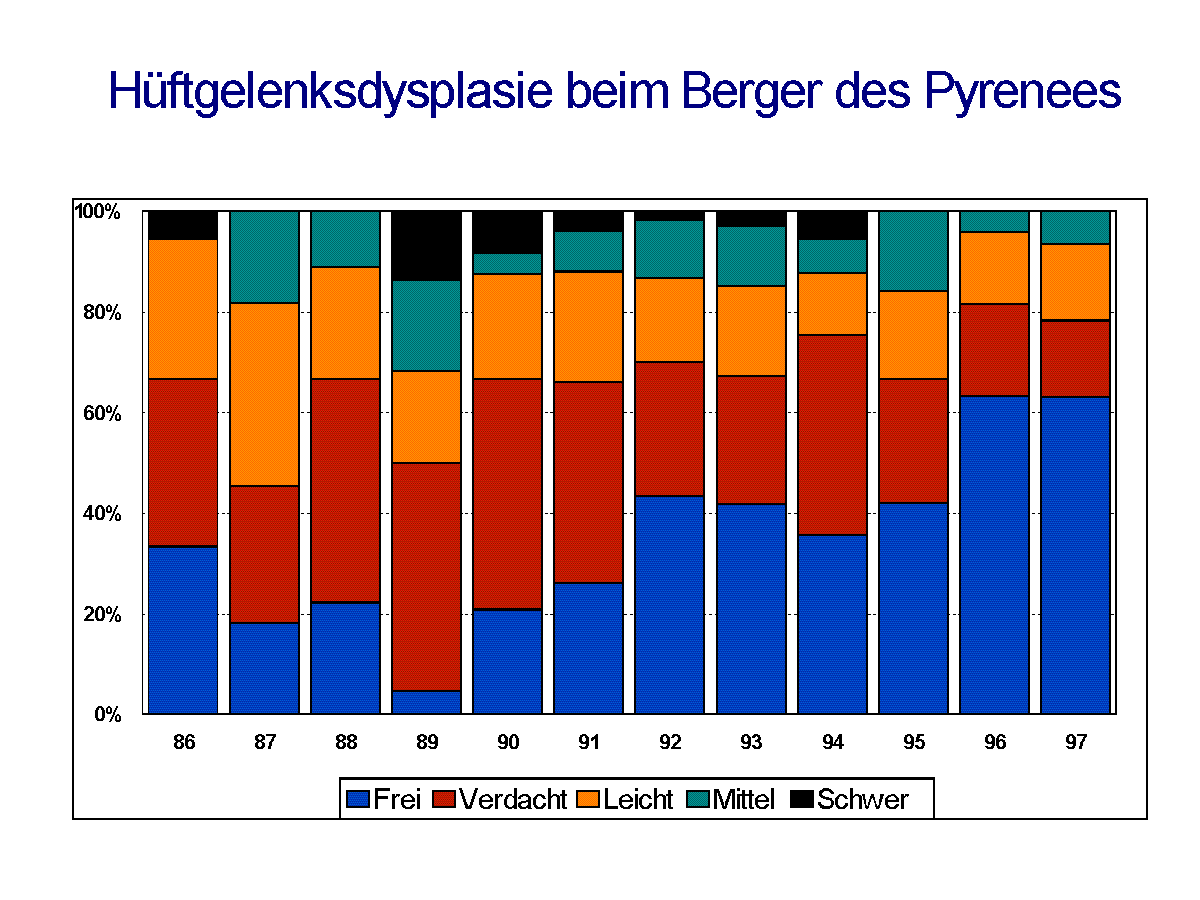|
|
|
|
The breed value assesment is developed by Dr. Reiner Beuing of
the Institute for animal husbandry and domestic animal genetics of the University of
Gießen .
Breed Value Assessment HD: What is it? Can we use it for the
Lhasa Apso? yes!
The right answers to the most prevalent questions.
"Where can I take my dog to have his breed value assessed?" , or "Which
Breed Value is better, over 100 or under 100?"
These are the questions about the Breed Value Assessment HD.
1. How is the Breed Value HD worked out for my dog? What is the formula for it?
There is no precise formula in these calculations. The Breed Value of every animal is
considered "unknown" at the beginning of the calculations. Then an equation is
put up for every animal, of the formula:
HD = the breed average + Breed Value of this animal + variation of sex + other influences.
In this equation the breed average, breed value and the effect of the sex are formulated
as the "cause" of HD. In the SV(German Shepperd), 450,000 equations are
formulated for 450,000 animals, with the 450,000 unknown Breed Values. Then some
supplementary conditions (stipulations or prerequisites) of the laws of inheritance and
heredity are mathematically formulated. Following this, the computer has to solve the
450,000 equations with the 450,000 unknown factors. The answers are the assessed
(estimated) Breed Values. This means that there is no formula, in which a dog's breed
value is worked out on its own.
2. What role does its own HD score play in my dog's HD Breed Value?
The dog's own HD grade modifies that, which was already known about the line (sire and
dam). Siblings, (same father and same mother) may differ through their own
HD status. If an animal has progeny, its own HD status slips more and more into the
background. With 30 - 40 progeny, it is practically of no consequence.
3. How is a foreign "a" evaluated for the Breed Value Assessment?
At this time, dogs from abroad with the "a" are evaluated in the formulations as
though they were not x-rayed. Their Breed Value Assessment is gained only through their x
rayed relatives. As these animals can not be clearly termed as "free" or
"still Acceptable", an assumption in this case, would be unfair.
4. How can a dog, that was not x -rayed, have a Breed Value for HD?
In the system of equations (see Answer 1), there is a lateral clause, that the father (and
the mother) give half of their genes to the progeny. Therefore the Breed Value of the
progeny can be assessed or estimated, if nothing is known about the animal ( un x-rayed),
as well as the breed value of the sire and dam are known. In the same way, a parent can be
assessed if the progeny is known, because progeny have one half of their genes from their
parents. Siblings on the one hand help to characterise the parents, the knowledge about
the breed value of the parents helps on the other hand, to assess the breed
value of the untested siblings.
5. How accurate can the Breed Value Assessment be, if for more than half of the whelps, no
HD information is available?
In the Breed Value Assessment, the percentage of the pups does not matter, but the
absolute number. The last Champion has at this point in time, 91 x-rayed progeny, who
characterise his heredity well. In the breed Value Assessment it is not the percentage of
the whelps that counts, but the total number! The last Sieger, at this point in time, has
his heritage well demonstrated by 91 progeny.
6. My bitch has passed on the "a" well up to now. What happens if I mate her to
a dog that has a HD Breed Value over 100?
If the bitch has produced well, this must be seen in her Breed Value. Good progeny
however, can also be the result of good matings. If the bitch, for instance, is mated to a
dog with a value of 100, then the risk for the puppies is higher. The bitch is only
"accredited negatively" if the pups are worse than could be expected with that
dog.
Generally it is a fact that the stud dog owner would be well advised if he also accepted
"poor" bitches, because with the poor bitches a dog can show plainly that he
"improves"
With HD, where there is no freer than free, it is difficult to prove a positive
heritability of the top bitches.
7. How do dogs that have no HD findings flow into the HD Breed Value calculations?
At this stage un-x rayed animals are neutral for the Breed Value Assessment, they are not
taken into consideration.
8. What does the mean Breed Value of 100 mean, and the stated deviation of the standard of
ten points mentioned in the breeding plan?
The Breed Value of 100 means, that the animal's heredity is typical for the breed. At this
time the breed mean is 1,71, that is between HD free and slight HD. What is passed on, can
be better or worse than 100.The average deviation above or below this, will be set at 10
points for the mean.
9. What does a Breed Value over 100 mean for my dog?
The Breed Value for one's own dog means that he passes on poorly. As the breed average
itself is still unsatisfactory, matings should be strived for, that lie under 100. With
this, "you must not throw out the baby with the bath water." The first priority
is working ability, temperament and so on. If one finds a stud dog who brings the
expectations for the pups (the average of father and mother) below the 100 value, that is
sufficient.
10. Conversely, what does a breed value below 100 mean for my dog?
A Breed Value below 100 means, that there is a greater freedom in the choice of dogs firm
in character, strong in performance and of good construction, even if their breed value is
around 100. With a bitch value of 83, one can even accept a dog of 117!
A breed value Assessment can be taken for other characteristics. For this, it
is important, that the characteristic is accurately defined. The inheritance of size by
example, lens luxation, litter size, etc.
![]() Top
Top
EXPERIENCES WITH BREED VALUE ASSESSMENTS
The breed value assesment is developed by Dr. Reiner
Beuing of the Institute for animal husbandry and domestic animal genetics of the
University of Gießen .
The HD Breed Value Assessments,
which depict the risk factor for the heritability of Hip Dysplasia (HD) are now generally
available in the German Shepherd Club. In the Netherlands and Belgium the breed value assesment
system has become more and more
populair.
SV= German Shepherd club, HD= hipdysplasia.
The application of the BV Assessment is
very simple for the breeder. A Breed value of 100 characterises an animal whose heredity
is typical for the breed.
Dogs with a breed value under 100 reduce the HD risk in the progeny, animals with
breed values over 100 would intensify the problem of HD.
The breeder can select a stud dog for his bitch, whose breed value he knows, from the huge
selection of breed surveyed dogs, who also conform to his wishes in respect of anatomy and
performance.
The breeding plan to combat HD is comprehensively formulated and easy to apply.
The aim is to breed puppies with a value of under 100, that is with an under average
HD hereditability. This value is gained from half the Father's breed value plus half of
the mother's breed value, just as the genetic makeup of the puppy comprises half of the
father, and half of the mother's genes. With the clear understanding of the HD findings
that is created through the publication of the breed value of all animals, and updated
every 3 months, the bitch owner now has the opportunity to breed, meeting his
responsibilities. The SV has joined the avant garde of cynology by implementing the Breed
Value Assessment.
Modern breed value assessment for HD in the dog, taking into consideration all related
animals, was commenced in 1983 with the German Spaniel. (D.Wachtelhund) The German Hunting
Terrier followed suit with the Breed Value Assessments for the hereditability of lens
luxation. (LL) This eye defect, typical for Terriers, had a frequency of around 2%.
Together with this, the breeders were offered the Breed Value for hereditability of size
and of four hunting attributes. (Nose, giving tongue, working under ground and love of
water)
With the availability of a Breed Value Assessment, there arose insecurity in the
application of the findings. As the breed value figures are only an assessment, an
estimation, and therefore depend largely on the current documented findings, a selection
with the view of a general disqualification from breeding for animals burdened with a
hereditary disposition towards the defect does not make sense. It is not feasible that a
bitch is barred from breeding today, and readmitted with the next breed value assessment,
and then barred again. The manner of dealing with this, must be made more flexible.

figure shows the decrease of HD defects using Breed value assesment.
The concept, of not depending on the suitability of
breeding animals (parents) as prerequisite, but to build on the suitability of a mating,
was absolutely new in animal breeding. The principle of a "strategic mating" was
born. Every animal is suitable for breeding if, with a suitable partner, it produces below
average hereditary disease factor progeny.
The principle of this breeding plan was adopted by the German Retriever Club (DRC) for
Golden Retrievers, and was also adopted by the Hovawart Breed Club as their breeding
strategy. While the Retriever breeders have altered their mandatory clause to
"recommendation to responsible breeders" after the first (successful) year, the
Hovawart breeders have strictly adhered to their breeding plans.
The positive principle fell upon fruitful ground in the Retriever club, because even
though they only bred with HD free dogs, the up till then positive trend dropped back from
1984 onwards. The number of HD-free animals went steadily down. With introduction of the
Breed Value Assessment 1989, taking the HD grades of all relatives into consideration, it
was now possible to differentiate between those HD free dogs that are producers of good
hips, and those that are not.

This figure shows the decrease of diaphragmluxation.
The flexible breeding plan, that leaves all bitches in the
kennels principally untouched, and therefore maintains the breeding potential and the
continued breeding programme in the kennels, immediately reversed the trend. Today, the
90% mark for HD free animals has been surpassed with pride, with an x-raying quota of 70%!
The Hunting Terrier breeders however, found it more difficult. Lense Luxation appears
between the 3rd and 5th year of life, and was often kept secret. The honest ones felt
deceived, and the diagnosis was not always made by a competent ophthalmologist. That's why
a breeding plan had to be formulated that as well as the Breed Value Assessment also had
supporting conditions in regard to the obtaining and accuracy of information.
A network of appointed veterinarians was created, entrusted with giving the concerned
owners competent advice and help. A communal treasury was put into effect, into which
every breeder paid DM 10.00 per puppy. From this treasury, assistance to the tune of DM
500.00 was paid to owners to soften the cost of the necessary eye operation. DNA testing
ensured that the affected puppy was not accredited to the wrong parents.
Overall a campaign of education with articles and breeder seminars, has led to this
hereditary defect being dealt with in a responsible and less emotive manner. How strongly
the breeders now feel the responsibility towards their breeding aims. When the Breed
Values were published, and the principles of Strategic Matings were begun to be
understood, (limit for matings not higher than 105) the yearly average for LL dropped from
year to year. The breed standard that has swung up to 112 in the beginning, has dropped,
today, down to 95. The frequency of affected animals lays at 0,8% even though the
reporting of cases has risen through the guarantee certificate that is issued with every
pedigree.
The fact that through the Breed Value Assessment, a measurable criterion is within reach,
and a breeder can now document his efforts towards producing soundness, seems to me, to be
the driving force. Successful breeding in respect to conformation and performance was
honoured, up to now, with the Sieger title, Championships and trophies. Now it will
certainly become attractive to present animals free from hereditary disease. How important
a breeding programme such as that of the SV is, and how important it is to put it into
effect unwaveringly, shall be demonstrated with the Club Berger des Pyrenees (Pyrenean
Mountain Dog), who. as a new club instituted the Breed Value Assessment with Strategic
Matings (limit 102). The first x ray campaign did not give a rosy picture with less than
10% of free animals. The Breed Value Assessment however immediately placed the finger on
the root of the problem, and already in the next year there was a rise in the HD free
animals. As a result of this breeding strategy no longer being mandatory from the year
1992, but "only" as a recommendation, the number of HD free animals dropped
again. The club was well advised in 1995, to decree that the breeding regulations were to
be mandatory again.
Today, HD is practically no longer a restricting problem in the Pyrenean Mountain Dog.
Through a bond for x raying, a figure of around 60 to 70 % of submission is achieved.
Almost every bitch finds a sufficient number of breeding partners which safeguard the
upper limit-value for the mating.

This figure shows the decrease of HD by the Pyrenean Mountain Dog.
Further breeds could be named, whose successful breeding is supported by breed value
figures.
Text and illustrations from the german shepherd club, here and there
donations from S.H.M. van Tatenhove van Roosenbroek for Lhasa Apso purposes.
|
Breed Value Assessment HD: What is it? |